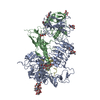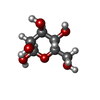[English] 日本語
 Yorodumi
Yorodumi- PDB-7s0q: Head region of a complex of IGF-I with the ectodomain of a hybrid... -
+ Open data
Open data
- Basic information
Basic information
| Entry | Database: PDB / ID: 7s0q | ||||||
|---|---|---|---|---|---|---|---|
| Title | Head region of a complex of IGF-I with the ectodomain of a hybrid insulin receptor / type 1 insulin-like growth factor receptor | ||||||
 Components Components |
| ||||||
 Keywords Keywords | SIGNALING PROTEIN / insulin receptor / type 1 insulin like growth factor receptor / hybrid receptor / insulin like growth factor I / leucine zipper / cryo electron microscopy | ||||||
| Function / homology |  Function and homology information Function and homology informationglycolate metabolic process / muscle hypertrophy / negative regulation of oocyte development / positive regulation of trophectodermal cell proliferation / insulin-like growth factor binding protein complex / insulin-like growth factor ternary complex / cardiac atrium development / proteoglycan biosynthetic process / negative regulation of cholangiocyte apoptotic process / positive regulation of glycoprotein biosynthetic process ...glycolate metabolic process / muscle hypertrophy / negative regulation of oocyte development / positive regulation of trophectodermal cell proliferation / insulin-like growth factor binding protein complex / insulin-like growth factor ternary complex / cardiac atrium development / proteoglycan biosynthetic process / negative regulation of cholangiocyte apoptotic process / positive regulation of glycoprotein biosynthetic process / myotube cell development / skeletal muscle satellite cell maintenance involved in skeletal muscle regeneration / insulin-like growth factor receptor activity / positive regulation of steroid hormone biosynthetic process / protein kinase complex / negative regulation of neuroinflammatory response / negative regulation of vascular associated smooth muscle cell apoptotic process / bone mineralization involved in bone maturation / Signaling by Type 1 Insulin-like Growth Factor 1 Receptor (IGF1R) / positive regulation of cell growth involved in cardiac muscle cell development / protein transporter activity / IRS-related events triggered by IGF1R / insulin-like growth factor binding / exocytic vesicle / regulation of female gonad development / negative regulation of muscle cell apoptotic process / cellular response to progesterone stimulus / positive regulation of meiotic cell cycle / positive regulation of DNA metabolic process / cellular response to zinc ion starvation / cellular response to aldosterone / positive regulation of developmental growth / cell activation / positive regulation of calcineurin-NFAT signaling cascade / insulin-like growth factor II binding / male sex determination / exocrine pancreas development / insulin receptor complex / cellular response to testosterone stimulus / negative regulation of hepatocyte apoptotic process / positive regulation of transcription regulatory region DNA binding / insulin-like growth factor I binding / insulin receptor activity / transcytosis / alphav-beta3 integrin-IGF-1-IGF1R complex / response to alkaloid / positive regulation of Ras protein signal transduction / positive regulation of protein-containing complex disassembly / cellular response to angiotensin / myoblast differentiation / positive regulation of insulin-like growth factor receptor signaling pathway / cargo receptor activity / myoblast proliferation / muscle organ development / dendritic spine maintenance / negative regulation of interleukin-1 beta production / cellular response to insulin-like growth factor stimulus / response to L-glutamate / insulin binding / PTB domain binding / negative regulation of MAPK cascade / adrenal gland development / establishment of cell polarity / neuronal cell body membrane / Signaling by Insulin receptor / IRS activation / activation of protein kinase activity / positive regulation of activated T cell proliferation / positive regulation of cardiac muscle hypertrophy / positive regulation of smooth muscle cell migration / positive regulation of axon regeneration / amyloid-beta clearance / negative regulation of release of cytochrome c from mitochondria / positive regulation of osteoblast proliferation / positive regulation of respiratory burst / positive regulation of cytokinesis / negative regulation of amyloid-beta formation / negative regulation of smooth muscle cell apoptotic process / Respiratory syncytial virus (RSV) attachment and entry / positive regulation of receptor internalization / regulation of embryonic development / regulation of JNK cascade / transport across blood-brain barrier / negative regulation of tumor necrosis factor production / insulin receptor substrate binding / positive regulation of glycogen biosynthetic process / estrous cycle / G-protein alpha-subunit binding / response to vitamin E / Synthesis, secretion, and deacylation of Ghrelin / epidermis development / epithelial to mesenchymal transition / positive regulation of DNA binding / SHC-related events triggered by IGF1R / Signal attenuation / positive regulation of osteoblast differentiation / phosphatidylinositol 3-kinase binding / heart morphogenesis / peptidyl-tyrosine autophosphorylation / positive regulation of tyrosine phosphorylation of STAT protein Similarity search - Function | ||||||
| Biological species |  Homo sapiens (human) Homo sapiens (human) | ||||||
| Method | ELECTRON MICROSCOPY / single particle reconstruction / cryo EM / Resolution: 3.7 Å | ||||||
 Authors Authors | Xu, Y. / Lawrence, M.C. | ||||||
| Funding support |  Australia, 1items Australia, 1items
| ||||||
 Citation Citation |  Journal: Structure / Year: 2022 Journal: Structure / Year: 2022Title: How insulin-like growth factor I binds to a hybrid insulin receptor type 1 insulin-like growth factor receptor. Authors: Yibin Xu / Mai B Margetts / Hari Venugopal / John G Menting / Nicholas S Kirk / Tristan I Croll / Carlie Delaine / Briony E Forbes / Michael C Lawrence /   Abstract: Monomers of the insulin receptor and type 1 insulin-like growth factor receptor (IGF-1R) can combine stochastically to form heterodimeric hybrid receptors. These hybrid receptors display ligand ...Monomers of the insulin receptor and type 1 insulin-like growth factor receptor (IGF-1R) can combine stochastically to form heterodimeric hybrid receptors. These hybrid receptors display ligand binding and signaling properties that differ from those of the homodimeric receptors. Here, we describe the cryoelectron microscopy structure of such a hybrid receptor in complex with insulin-like growth factor I (IGF-I). The structure (ca. 3.7 Å resolution) displays a single IGF-I ligand, bound in a similar fashion to that seen for IGFs in complex with IGF-1R. The IGF-I ligand engages the first leucine-rich-repeat domain and cysteine-rich region of the IGF-1R monomer (rather than those of the insulin receptor monomer), consistent with the determinants for IGF binding residing in the IGF-1R cysteine-rich region. The structure broadens our understanding of this receptor family and assists in delineating the key structural motifs involved in binding their respective ligands. | ||||||
| History |
|
- Structure visualization
Structure visualization
| Structure viewer | Molecule:  Molmil Molmil Jmol/JSmol Jmol/JSmol |
|---|
- Downloads & links
Downloads & links
- Download
Download
| PDBx/mmCIF format |  7s0q.cif.gz 7s0q.cif.gz | 349.6 KB | Display |  PDBx/mmCIF format PDBx/mmCIF format |
|---|---|---|---|---|
| PDB format |  pdb7s0q.ent.gz pdb7s0q.ent.gz | 280.2 KB | Display |  PDB format PDB format |
| PDBx/mmJSON format |  7s0q.json.gz 7s0q.json.gz | Tree view |  PDBx/mmJSON format PDBx/mmJSON format | |
| Others |  Other downloads Other downloads |
-Validation report
| Summary document |  7s0q_validation.pdf.gz 7s0q_validation.pdf.gz | 1011.4 KB | Display |  wwPDB validaton report wwPDB validaton report |
|---|---|---|---|---|
| Full document |  7s0q_full_validation.pdf.gz 7s0q_full_validation.pdf.gz | 1024 KB | Display | |
| Data in XML |  7s0q_validation.xml.gz 7s0q_validation.xml.gz | 34.8 KB | Display | |
| Data in CIF |  7s0q_validation.cif.gz 7s0q_validation.cif.gz | 50.1 KB | Display | |
| Arichive directory |  https://data.pdbj.org/pub/pdb/validation_reports/s0/7s0q https://data.pdbj.org/pub/pdb/validation_reports/s0/7s0q ftp://data.pdbj.org/pub/pdb/validation_reports/s0/7s0q ftp://data.pdbj.org/pub/pdb/validation_reports/s0/7s0q | HTTPS FTP |
-Related structure data
| Related structure data |  24791MC  7s8vC M: map data used to model this data C: citing same article ( |
|---|---|
| Similar structure data | Similarity search - Function & homology  F&H Search F&H Search |
- Links
Links
- Assembly
Assembly
| Deposited unit | 
|
|---|---|
| 1 |
|
- Components
Components
-Insulin-like growth factor ... , 2 types, 2 molecules AD
| #1: Protein | Mass: 108937.242 Da / Num. of mol.: 1 Source method: isolated from a genetically manipulated source Source: (gene. exp.)  Homo sapiens (human) / Gene: IGF1R / Cell line (production host): CHO Lec8 / Production host: Homo sapiens (human) / Gene: IGF1R / Cell line (production host): CHO Lec8 / Production host:  References: UniProt: P08069, receptor protein-tyrosine kinase |
|---|---|
| #3: Protein | Mass: 7663.752 Da / Num. of mol.: 1 Source method: isolated from a genetically manipulated source Source: (gene. exp.)  Homo sapiens (human) / Gene: IGF1, IBP1 / Production host: Homo sapiens (human) / Gene: IGF1, IBP1 / Production host:  |
-Protein , 1 types, 1 molecules B
| #2: Protein | Mass: 109809.617 Da / Num. of mol.: 1 Source method: isolated from a genetically manipulated source Source: (gene. exp.)  Homo sapiens (human) / Gene: INSR / Cell line (production host): CHO lek8 / Production host: Homo sapiens (human) / Gene: INSR / Cell line (production host): CHO lek8 / Production host:  References: UniProt: P06213, receptor protein-tyrosine kinase |
|---|
-Sugars , 4 types, 11 molecules 


| #4: Polysaccharide | Source method: isolated from a genetically manipulated source #5: Polysaccharide | 2-acetamido-2-deoxy-beta-D-glucopyranose-(1-4)-2-acetamido-2-deoxy-beta-D-glucopyranose | Source method: isolated from a genetically manipulated source #6: Sugar | ChemComp-BMA / | #7: Sugar | ChemComp-NAG / |
|---|
-Details
| Has ligand of interest | Y |
|---|
-Experimental details
-Experiment
| Experiment | Method: ELECTRON MICROSCOPY |
|---|---|
| EM experiment | Aggregation state: PARTICLE / 3D reconstruction method: single particle reconstruction |
- Sample preparation
Sample preparation
| Component | Name: a complex of IGF-I with the ectodomain of a hybrid insulin receptor / type 1 insulin-like growth factor receptor Type: COMPLEX / Entity ID: #1-#3 / Source: MULTIPLE SOURCES |
|---|---|
| Molecular weight | Value: 250 kDa/nm / Experimental value: YES |
| Source (natural) | Organism:  Homo sapiens (human) Homo sapiens (human) |
| Source (recombinant) | Organism:  |
| Buffer solution | pH: 8 / Details: 20mM Tris pH 8.0 160mM NaCl |
| Buffer component | Conc.: 20 mM / Name: TRIS / Formula: C4H11NO3 |
| Specimen | Embedding applied: NO / Shadowing applied: NO / Staining applied: NO / Vitrification applied: YES / Details: 0.2mg/ml |
| Specimen support | Grid material: COPPER |
| Vitrification | Instrument: FEI VITROBOT MARK IV / Cryogen name: ETHANE |
- Electron microscopy imaging
Electron microscopy imaging
| Experimental equipment |  Model: Titan Krios / Image courtesy: FEI Company |
|---|---|
| Microscopy | Model: FEI TITAN KRIOS |
| Electron gun | Electron source:  FIELD EMISSION GUN / Accelerating voltage: 300 kV / Illumination mode: OTHER FIELD EMISSION GUN / Accelerating voltage: 300 kV / Illumination mode: OTHER |
| Electron lens | Mode: BRIGHT FIELD |
| Image recording | Electron dose: 1.44 e/Å2 / Detector mode: COUNTING / Film or detector model: GATAN K2 SUMMIT (4k x 4k) |
- Processing
Processing
| Software | Name: PHENIX / Version: 1.17_3644: / Classification: refinement | ||||||||||||||||||||||||||||
|---|---|---|---|---|---|---|---|---|---|---|---|---|---|---|---|---|---|---|---|---|---|---|---|---|---|---|---|---|---|
| EM software |
| ||||||||||||||||||||||||||||
| CTF correction | Type: NONE | ||||||||||||||||||||||||||||
| Symmetry | Point symmetry: C1 (asymmetric) | ||||||||||||||||||||||||||||
| 3D reconstruction | Resolution: 3.7 Å / Resolution method: FSC 0.143 CUT-OFF / Num. of particles: 151240 / Symmetry type: POINT | ||||||||||||||||||||||||||||
| Atomic model building | Protocol: RIGID BODY FIT / Space: REAL | ||||||||||||||||||||||||||||
| Refine LS restraints |
|
 Movie
Movie Controller
Controller



 PDBj
PDBj
















